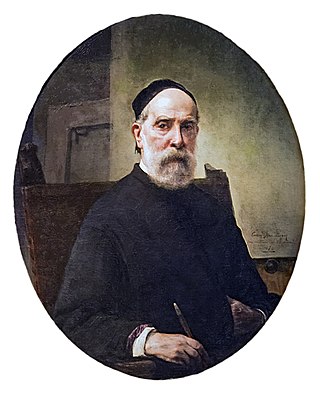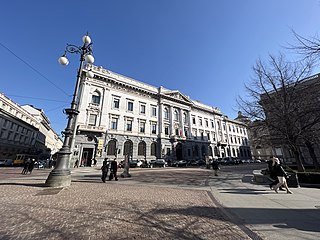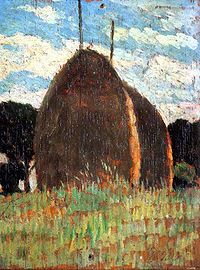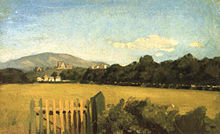A cultural movement is a change in the way a number of different disciplines approach their work. This embodies all art forms, the sciences, and philosophies. Historically, different nations or regions of the world have gone through their own independent sequence of movements in culture, but as world communications have accelerated this geographical distinction has become less distinct. When cultural movements go through revolutions from one to the next, genres tend to get attacked and mixed up, and often new genres are generated and old ones fade.: These changes are often reactions against the prior cultural form, which typically has grown stale and repetitive. An obsession emerges among the mainstream with the new movement, and the old one falls into neglect – sometimes it dies out entirely, but often it chugs along favored in a few disciplines and occasionally making reappearances.

Classicism, in the arts, refers generally to a high regard for a classical period, classical antiquity in the Western tradition, as setting standards for taste which the classicists seek to emulate. In its purest form, classicism is an aesthetic attitude dependent on principles based in the culture, art and literature of ancient Greece and Rome, with the emphasis on form, simplicity, proportion, clarity of structure, perfection, restrained emotion, as well as explicit appeal to the intellect. The art of classicism typically seeks to be formal and restrained: of the Discobolus Sir Kenneth Clark observed, "if we object to his restraint and compression we are simply objecting to the classicism of classic art. A violent emphasis or a sudden acceleration of rhythmic movement would have destroyed those qualities of balance and completeness through which it retained until the present century its position of authority in the restricted repertoire of visual images." Classicism, as Clark noted, implies a canon of widely accepted ideal forms, whether in the Western canon that he was examining in The Nude (1956).

Neoclassicism was a Western cultural movement in the decorative and visual arts, literature, theatre, music, and architecture that drew inspiration from the art and culture of classical antiquity. Neoclassicism was born in Rome largely thanks to the writings of Johann Joachim Winckelmann, at the time of the rediscovery of Pompeii and Herculaneum, but its popularity spread across Europe as a generation of European art students finished their Grand Tour and returned from Italy to their home countries with newly rediscovered Greco-Roman ideals. The main Neoclassical movement coincided with the 18th-century Age of Enlightenment, and continued into the early 19th century, latterly competing with Romanticism. In architecture, the style continued throughout the 19th, 20th and up to the 21st century.

The art of Europe, also known as Western art, encompasses the history of visual art in Europe. European prehistoric art started as mobile Upper Paleolithic rock and cave painting and petroglyph art and was characteristic of the period between the Paleolithic and the Iron Age. Written histories of European art often begin with the Aegean civilizations, dating from the 3rd millennium BC. However a consistent pattern of artistic development within Europe becomes clear only with Ancient Greek art, which was adopted and transformed by Rome and carried; with the Roman Empire, across much of Europe, North Africa and Western Asia.

The epithet Nazarene was adopted by a group of early 19th-century German Romantic painters who aimed to revive spirituality in art. The name Nazarene came from a term of derision used against them for their affectation of a biblical manner of clothing and hair style.

Francesco Hayez was an Italian painter. He is considered one of the leading artists of Romanticism in mid-19th-century Milan, and is renowned for his grand historical paintings, political allegories, and portraits.

Since ancient times, Greeks, Etruscans and Celts have inhabited the south, centre and north of the Italian peninsula respectively. The very numerous rock drawings in Valcamonica are as old as 8,000 BC, and there are rich remains of Etruscan art from thousands of tombs, as well as rich remains from the Greek colonies at Paestum, Agrigento and elsewhere. Ancient Rome finally emerged as the dominant Italian and European power. The Roman remains in Italy are of extraordinary richness, from the grand Imperial monuments of Rome itself to the survival of exceptionally preserved ordinary buildings in Pompeii and neighbouring sites. Following the fall of the Roman Empire, in the Middle Ages Italy remained an important centre, not only of the Carolingian art, Ottonian art of the Holy Roman Emperors, Norman art, but for the Byzantine art of Ravenna and other sites.
This is a chronological list of periods in Western art history. An art period is a phase in the development of the work of an artist, groups of artists or art movement.
Purismo was an Italian cultural movement which began in the 1820s. The group intended to restore and preserve language through the study of medieval authors, and such study extended to the visual arts.

Neoclassical architecture, sometimes referred to as Classical Revival architecture, is an architectural style produced by the Neoclassical movement that began in the mid-18th century in Italy, France and Germany. It became one of the most prominent architectural styles in the Western world. The prevailing styles of architecture in most of Europe for the previous two centuries, Renaissance architecture and Baroque architecture, already represented partial revivals of the Classical architecture of ancient Rome and ancient Greek architecture, but the Neoclassical movement aimed to strip away the excesses of Late Baroque and return to a purer and more authentic classical style, adapted to modern purposes.

The Macchiaioli were a group of Italian painters active in Tuscany in the second half of the nineteenth century. They strayed from antiquated conventions taught by the Italian art academies, and did much of their painting outdoors in order to capture natural light, shade, and colour. This practice relates the Macchiaioli to the French Impressionists who came to prominence a few years later, although the Macchiaioli pursued somewhat different purposes. The most notable artists of this movement were Giuseppe Abbati, Cristiano Banti, Odoardo Borrani, Vincenzo Cabianca, Adriano Cecioni, Vito D'Ancona, Serafino De Tivoli, Giovanni Fattori, Raffaello Sernesi, Silvestro Lega and Telemaco Signorini.

Giovanni Fattori was an Italian artist, one of the leaders of the group known as the Macchiaioli. He was initially a painter of historical themes and military subjects. In his middle years, inspired by the Barbizon school, he became one of the leading Italian plein-airists, painting landscapes, rural scenes, and scenes of military life. After 1884, he devoted much energy to etching.

Italy has a very broad and diverse architectural style, which cannot be simply classified by period or region, due to Italy's division into various small states until 1861. This has created a highly diverse and eclectic range in architectural designs. Italy is known for its considerable architectural achievements, such as the construction of aqueducts, temples and similar structures during ancient Rome, the founding of the Renaissance architectural movement in the late-14th to 16th century, and being the homeland of Palladianism, a style of construction which inspired movements such as that of Neoclassical architecture, and influenced the designs which noblemen built their country houses all over the world, notably in the United Kingdom, Australia and the United States of America during the late-17th to early 20th centuries.
In architecture, Rationalism is an architectural current which mostly developed from Italy in the 1920s and 1930s. Vitruvius had claimed in his work De architectura that architecture is a science that can be comprehended rationally. The formulation was taken up and further developed in the architectural treatises of the Renaissance. Eighteenth-century progressive art theory opposed the Baroque use of illusionism with the classic beauty of truth and reason.

Italian Neoclassical architecture refers to architecture in Italy during the Neoclassical period (1750s–1850s).

Rome has for over two thousand years been one of the most important artistic centres in the world. Early Ancient Roman art initially developed from the Etruscan art slightly to its north, but from about 2000 BC, as the Roman republic became involved with the Greek world, Ancient Greek art and architecture became the dominant influence, until the two effectively merged into a Greco-Roman style, often meaning Greek-speaking artists working for Latin-speaking patrons. Roman literature and philosophy was also centred on the capital.

This timeline shows the periods of various architectural styles in the architecture of Italy. Italy's architecture spans almost 3,500 years, from Etruscan and Ancient Roman architecture to Romanesque, Gothic, Renaissance, Baroque, Rococo, Neoclassical, Art Nouveau, Fascist, and Italian modern and contemporary architecture.

The Gallerie d'Italia - Milano is a modern and contemporary museum in Milan, Italy. Located in Piazza della Scala in the Palazzo Brentani and the Palazzo Anguissola, it hosts 195 artworks from the collections of Fondazione Cariplo with a strong representation of nineteenth century Lombard painters and sculptors, including Antonio Canova and Umberto Boccioni. A new section was opened in the Palazzo della Banca Commerciale Italiana on October 25, 2012 with 189 art works from the twentieth century.

Caffè Michelangiolo was a historic café in Florence, located in Via Larga. During the nineteenth century Wars of Italian Independence, it became a major meeting place for Tuscan writers and artists, and for patriots and political exiles from other Italian states.

Diego Martelli was an Italian art critic who was one of the first supporters of Impressionism in Italy. He was a defender and associate of the Tuscan artists the Macchiaioli, whom he often hosted at his estate in Castiglioncello.


















